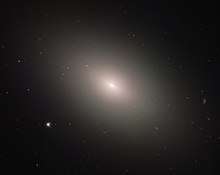Messier 59
Messier 59 or M59, also known as NGC 4621, is an elliptical galaxy in the equatorial constellation of Virgo. M59 is a member of the Virgo Cluster, with the nearest component being separated from M59 by 8′ and around 5 magnitudes fainter. The nearest cluster member of comparable brightness is the lenticular galaxy NGC 4638, which is around 17′ away.[9] Messier 59 and the nearby elliptical galaxy Messier 60 were both discovered by Johann Gottfried Koehler in April 1779 during observations of a comet in the same part of the sky. Charles Messier listed both in the Messier Catalogue about three days after Koehler's discovery.[10]
| Messier 59 | |
|---|---|
 | |
| Observation data (J2000 epoch) | |
| Constellation | Virgo[2] |
| Right ascension | 12h 42m 02.322s[3] |
| Declination | +11° 38′ 48.95″[3] |
| Redshift | 410±6 km/s[4] |
| Helio radial velocity | 438[5] km/s |
| Distance | 50.1 Mly (15.35 Mpc)[5] |
| Group or cluster | Virgo Cluster |
| Apparent magnitude (V) | 10.6[4] |
| Characteristics | |
| Type | E5[6] |
| Apparent size (V) | 5′.4 × 3′.7[4] |
| Half-light radius (apparent) | 46″[7] |
| Other designations | |
| GC 3155, NGC 4621, PGC 42628, UGC 7858[8] | |
This is an elliptical galaxy of type E5[6] with a position angle of 163.3°,[7] indicating the overall shape shows a flattening of 50%.[11] However, isophotes for this galaxy deviate from a perfect ellipticity, showing pointed shapes instead. These can be decomposed mathematically into a three component model, with each part having a different eccentricity. The main elliptical component appears to be superimposed upon a flatter, disk-like feature, with the entirety embedded within a circular halo. The luminosity contribution of the components is 62% for the pure elliptical part, 22% for the halo, and the remainder coming from the disk. The light ratio of the disk to the main elliptical body is 0.25, whereas it is typically closer to 0.5 in a lenticular galaxy.[9][12]
The core contains a supermassive black hole (SMBH), with a mass that has been estimated to be 270 million times the mass of the Sun,[13] and counter-rotates with respect of the rest of the galaxy, being bluer.[14] The SMBH is quiescent, but is detectable as an X-ray and radio source that indicates an outflow.[13] The nucleus contains an embedded stellar disk that is bluer (younger) than the bulge region, with a blue component stretching along a position angle of around 150°. This extended disk feature may be the result of a galactic merger followed by a starburst event.[12]
Messier 59 is very rich in globular clusters, with a population of them that has been estimated to be around 2,200.[15] It has a satellite, the Ultra Compact Dwarf galaxy M59-UCD3.[16]
One supernova (1939B) has been recorded in M59; it reached a peak magnitude of 11.9.[17] The region where this supernova occurred shows no trace of star formation, which suggests this was a type Ia supernova.[18]
References
- "Bucking the trend". www.spacetelescope.org. Retrieved 27 May 2019.
- R. W. Sinnott, ed. (1988). The Complete New General Catalogue and Index Catalogue of Nebulae and Star Clusters by J. L. E. Dreyer. Sky Publishing Corporation / Cambridge University Press. ISBN 978-0-933346-51-2.
- Skrutskie, M. F.; et al. (February 2006), "The Two Micron All Sky Survey (2MASS)", The Astronomical Journal, 131 (2): 1163–1183, Bibcode:2006AJ....131.1163S, doi:10.1086/498708.
- "NASA/IPAC Extragalactic Database". Results for NGC 4621. Retrieved 2006-11-18.
- Tully, R. Brent; et al. (August 2016), "Cosmicflows-3", The Astronomical Journal, 152 (2): 21, arXiv:1605.01765, Bibcode:2016AJ....152...50T, doi:10.3847/0004-6256/152/2/50, 50.
- King, I. R.; Minkowski, R. (March 1966), "Some Properties of Elliptical Galaxies", Astrophysical Journal, 143: 1002, Bibcode:1966ApJ...143.1002K, doi:10.1086/148580.
- Long, R. J.; Mao, Shude (April 2012), "Made-to-measure galaxy models - II. Elliptical and lenticular galaxies", Monthly Notices of the Royal Astronomical Society, 421 (3): 2580–2592, arXiv:1201.0951, Bibcode:2012MNRAS.421.2580L, doi:10.1111/j.1365-2966.2012.20488.x.
- "M 59". SIMBAD. Centre de données astronomiques de Strasbourg. Retrieved 2006-11-16.
- Mizuno, Takao; Oikawa, Ken-Ichi (1996). "Two-Dimensional Decomposition of a Disky Elliptical Galaxy, NGC 4621". Publications of the Astronomical Society of Japan. 48 (4): 591–600. Bibcode:1996PASJ...48..591M. doi:10.1093/pasj/48.4.591.
- K. G. Jones (1991). Messier's Nebulae and Star Clusters (2nd ed.). Cambridge University Press. ISBN 978-0-521-37079-0.
- Van den Bergh, Sidney (1998), Galaxy Morphology and Classification, Cambridge University Press, p. 47, ISBN 978-0521623353
- Krajnović, D.; Jaffe, W. (2004). "HST observations of nuclear stellar disks". Astronomy & Astrophysics. 428 (3): 877–890. arXiv:astro-ph/0409061. Bibcode:2004A&A...428..877K. doi:10.1051/0004-6361:20040359.
- Wrobel, J. M.; et al. (March 2008). "Outflow-dominated Emission from the Quiescent Massive Black Holes in NGC 4621 and NGC 4697". The Astrophysical Journal. 675 (2): 1041–1047. arXiv:0712.1308. Bibcode:2008ApJ...675.1041W. doi:10.1086/527542.
- Wernli, F.; et al. (2002). "A 60 pc counter-rotating core in NGC 4621". Astronomy & Astrophysics. 396: 73–81. arXiv:astro-ph/0209361. Bibcode:2002A&A...396...73W. doi:10.1051/0004-6361:20021333.
- Harris, William E. (1991). "Globular Cluster Systems in Galaxies Beyond the Local Group". Annual Review of Astronomy and Astrophysics. 29: 543–579. Bibcode:1991ARA&A..29..543H. doi:10.1146/annurev.aa.29.090191.002551. Retrieved 2012-07-21.
- Sandoval, Michael A.; et al. (23 July 2015). "Hiding in plain sight: record-breaking compact stellar systems in the Sloan Digital Sky Survey". The Astrophysical Journal. 808 (1): L32. arXiv:1506.08828. Bibcode:2015ApJ...808L..32S. doi:10.1088/2041-8205/808/1/L32.
- "List of Supernovae". IAU Central Bureau for Astronomical Telegrams.
- Perets, Hagai B.; et al. (April 2011), "An Emerging Class of Bright, Fast-evolving Supernovae with Low-mass Ejecta", The Astrophysical Journal, 730 (2): 7, arXiv:1008.2754, Bibcode:2011ApJ...730...89P, doi:10.1088/0004-637X/730/2/89, 89.
External links
| Wikimedia Commons has media related to Messier 59. |
- Elliptical Galaxy M59 @ SEDS Messier pages
- Messier 59 on WikiSky: DSS2, SDSS, GALEX, IRAS, Hydrogen α, X-Ray, Astrophoto, Sky Map, Articles and images
